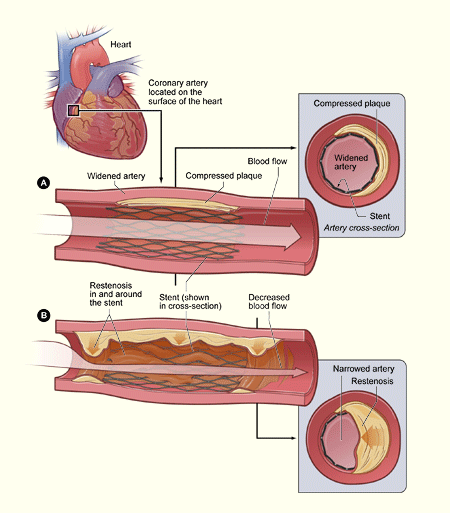What Are the Risks of Coronary Angioplasty?
Coronary angioplasty is a common medical procedure.
Although angioplasty is normally safe, there is a small risk of serious
complications, such as:
- Bleeding from the blood vessel where the catheter
was placed.
- Damage to blood vessels from the catheter.
- An allergic reaction to the dye given during the
angioplasty.
- An
arrhythmia
(irregular heartbeat).
- The need for emergency
coronary
artery bypass grafting during the procedure (2–4 percent of people).
This may occur when an artery closes down, instead of opening up.
- Damage to the kidneys caused by the dye
used.
- Heart
attack (3–5 percent of people).
- Stroke (less than 1 percent of people).
As with any procedure involving the heart,
complications can sometimes, though rarely, cause death. Less than 2 percent of
people die during angioplasty.
Sometimes chest pain can occur during angioplasty
because the balloon briefly blocks off the blood supply to the heart.
The risk of complications is higher in:
- People aged 75 and older
- People who have kidney disease or diabetes
- Women
- People who have poor pumping function in their
hearts
- People who have extensive heart disease and
blockages
Research on angioplasty is ongoing to make it safer
and more effective, to prevent treated arteries from closing again, and to make
the procedure an option for more people.
Complications From Stents
Restenosis
There is a chance that the artery will become
narrowed or blocked again in time, often within 6 months of angioplasty. This
is called restenosis.
Stent Restenosis

The illustration shows the
restenosis of a stent-widened coronary artery. The coronary artery is located
on the surface of the heart. In figure A, the expanded stent compresses plaque,
allowing normal blood flow. The inset image on figure A shows a cross-section
of the compressed plaque and stent-widened artery. In figure B, the plaque
grows (over time) through and around the stent, causing a partial blockage and
abnormal blood flow. The inset image on figure B shows a cross-section of the
growth of the plaque around the stent.
When a
stent
isn't used, 4 out of 10 people have restenosis. When a nonmedicine-coated stent
is used, 2 out of 10 people have restenosis.
The growth of scar tissue in and around the stent
also can cause restenosis. Medicine-coated stents reduce the growth of scar
tissue around the stent and lower the chance of restenosis. When
medicine-coated stents are used, the chance of restenosis is lowered even more,
to around 1 in 10 people.
Other treatments, such as radiation, can help
prevent tissue growth within a stent. For this procedure, the doctor puts a
wire through a catheter to where the stent is placed. The wire releases
radiation to stop any tissue growth that may block the artery.
Blood Clots
Recent studies suggest that there is a higher risk
of blood clots forming in medicine-coated stents compared to bare metal stents
(nonmedicine-coated). The Food and Drug Administration (FDA) reports that
medicine-coated stents usually don't cause complications due to blood clots
when used as recommended.
When medicine-coated stents are used in people with
advanced CAD, there is a higher risk of blood clots, heart attack, and death.
The FDA is working with researchers to study medicine-coated stents, including
their use in people with advanced CAD.
Taking medicine as prescribed by your doctor can
lower the risk of blood clots. People with medicine-coated stents are usually
advised to take an anticlotting drug, such as clopidogrel and aspirin, for
months to years to lower the risk of blood clots.
As with all procedures, it's important to talk to
your doctor about your treatment options, including the risks and benefits to
you.
|

